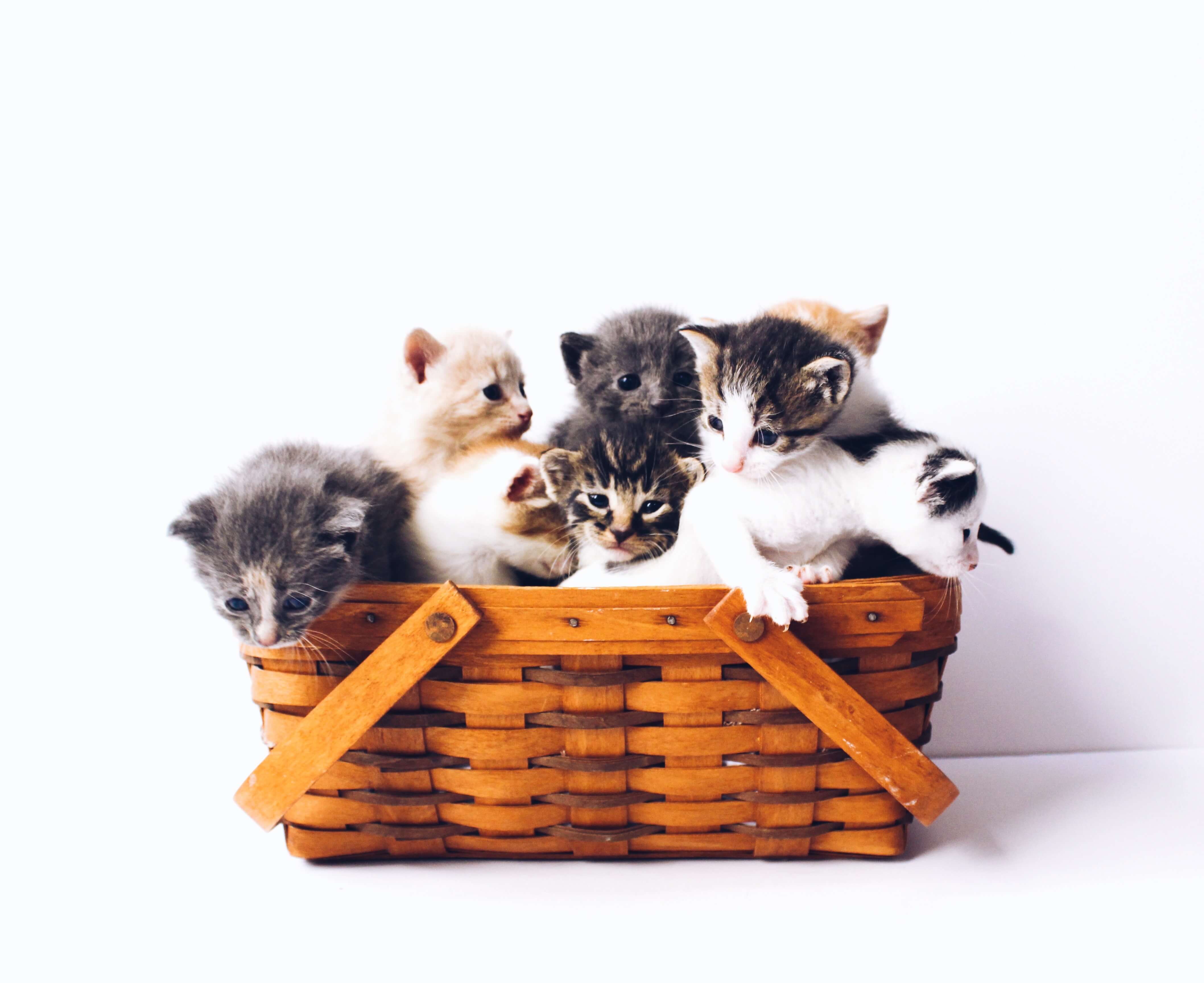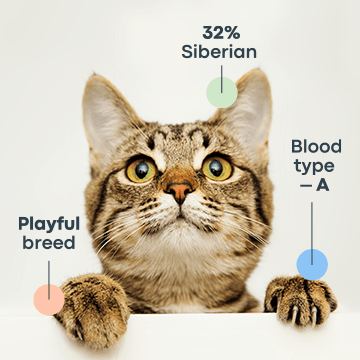Cat Fur Patterns
The various coat patterns and markings arise from the cat’s genetics, and the results can be stunning. Whether your feline is an ultra-rare blue Chartreux or a garden variety Tabby, all cats are gorgeous and hold a special place in our hearts.
According to an article published by Stanford Medicine, a gene called DKK4 helps control the early development of the various fur patterns in domestic cats.
Also, coat patterns in cats have typically evolved from their wild ancestors through natural selection, which means that several patterns gave camouflage advantages depending on their environment and the most effective ones were passed onto future generations. This resulted in a variety of stripes, spots, and rosettes.
The patterns that helped them blend into their environment were selected and became common among feline species. There are six varieties of cat fur patterns, including Tabby, Solid, Bicolor, Tricolor, Tortoiseshell, and Colorpoint.

Tabby
Tabby is the most common pattern for a cat's coat. There are several varieties of Tabby patterning, including Mackerel, Blotched, Spotted, and Ticked.
Classic (Blotched) Tabby
Blotched tabbies, or classic or marbled, have a combination of imperfections, swirls, and stripes all over their bodies. Classic tabbies are often confused with marbled Bengals. The classic tabby has solid black shoulder markings, whereas marbled Bengals have black outlined markings with rich brown inside, which also has speckles.
While on the body, the classic tabby has a round bullseye marking. The same marking on the marbled Bengal is usually elongated and broken, so the round bullseye may not appear.
Mackerel Tabby
Mackerel tabbies have stripes of dark fur running vertically along their bodies, with lighter orange or gray coats underneath.
These stripes can be uninterrupted or divided up along the stomach and flanks. Mackerel tabbies are known as fishbone tabbies; you may wonder why. Mackerels are fish that have defined striped patterns that run along the length of their backs. But that’s not why this pattern’s name is Mackerel, it is the fishbones left after the meat is picked.
Spotted Tabby
Spotted tabbies, as the name suggests, have spots of different colors over their fur. The number, size, and spacing of these spots vary, with popular Spotted tabby breeds including Maine Coon and Bengal.
Spotted tabby cat patterns also have a variation called the Rosetted tabby. This type of fur pattern is seen in Bengal and Savannah cats. Rosetted tabby has two-toned spots, each consisting of an outline in a slightly darker color.
Ticked Tabby
Ticked tabbies have a gradient of color in each fur follicle, with a lighter shade at the base and a darker color at the tip. They may also have a long dark line that runs along their spine. This is one of the cat fur patterns that is more common in Somali and Abyssinian cat breeds. Also, apart from the distinctive “M” marking on the forehead, many ticked tabbies have bold eye markings.
Patched Tabby
The patched tabby fur pattern is a combination of two patterns: tabby and tortoiseshell, known as Torbie. This combination creates a two-toned tabby with patches of two colors, for example, a brown tabby with patches of orange or cream forming a tabby pattern.
Solid
If you are wondering why some cats like Turkish Angora do not have any distinctive tabby pattern, all thanks to genetics. Solid color cats have a recessive mutation in the agouti gene, suppressing the tabby pattern. It means that the same consistency of pigment runs the length of hair.
From snow-white Turkish Angora to stone gray British Shorthair, cats with Solid color fur patterning capture our attention. To be classified as a Solid colored cat, there should be only one color present on the cat’s body. Because of this, Solid colored cats are not particularly common. Some rare solid-colored cats include blue Chartreux, copper Turkish Van, Havana brown, lilac Burmese, and black smoke Egyptian Mau.
Bicolor
Bicolor cats show a fur coloration of white and one other color. This fur pattern is typical among mixed-breed cats. How about testing your cat’s DNA to see what mix of breeds they are?
There are many different pattern combinations seen in bicolored cats. Frequently visited color combinations are red and white and white and brown.
Tuxedo Cats
Tuxedo cats are always black with white paws, faces, and bellies, resembling formal wear. The bicolor coat in tuxedo cats results from genetics, just like calico and tortoiseshells. However, the key difference is that tuxies have an equal number of males and females.
This cat fur pattern is found in several cat breeds, including British Shorthair, Scottish Fold, Maine Coon, and Turkish Angora.
Van Pattern
Cats with a Van coat are primarily white, with areas of colored fur on their heads and tails.
Harlequin
Harlequin cats are mostly white with large colored patches, which can appear anywhere on the body.
Magpie
In a magpie fur pattern, there are black and white cat coat colors with splashes of color distributed randomly.
Mitted
A mitted coat pattern, which is common in Ragdolls, usually has a solid or point color with white paws. This makes them look like they are wearing mittens.
Tricolor and Tortoiseshell
Calico and tortoiseshell are terms used for tricolored cat coats. The major difference between the two is that tortoiseshell cats do not have white markings. Calico cats have coats with a combination of white, black, and red-orange. Also, tortoiseshell cats with tabby markings are known as Torbie cats.
Colorpoint
Colorpoints are gorgeous cats identified through the dark coloration on their faces, paws, and tails, contrasting the rest of their lighter-colored bodies. These markings are most commonly associated with Siamese cats but can also be seen in breeds such as Ragdoll and Himalayan.
Colorpoint is one of the rarest color patterns in cats and has developed due to a genetic mutation that leads to temperature-sensitive albinism. This genetic mutation also leads Colorpoint cats to have their characteristic blue eyes. The different types of points include:
Seal Point
A Seal Point cat has a cream or fawn-colored coat with dark brown points on their head, ears, tail, and feet.
Chocolate Point
A Chocolate Point Siamese cat has a cream-colored body with chocolate markings. This color point is a genetic variation of the Seal Point Siamese.
Blue Point
A Blue Point cat has a pale, cool-toned, bluish-white body with deep slate-gray bluish points.
Lilac Point
Lilac Point cats have lavender-gray or lilac color on their face, ears, paw pads, and tails.
These cats are the palest of the Colorpoint variations.
Flame Point
A Flame Point cat has a creamy white coat with orange markings on their face, ear, tail, and paws. Small parts of these markings may also be present on their body.
Lynx Point
The Lynx Point cat has tabby markings on the extremities, including the head, paws, and tail. Lynx Point cats come in various colors, which include blue, blue-cream, cream, lilac, lilac-cream chocolate, chocolate tortie, red, seal, and seal tortie.
Types of Cat Fur
Cat breeds have evolved to adapt to different climates through natural selection. This includes features, such as fur density and length, body shape, and even the size of the ear, which changes depending on the temperature and conditions of their geographic origin. For example, Siberian cat breeds developed thick, long fur with a dense undercoat to fight against harsh winters while Siamese cats, which are from hot climates, have short, sleek coats for heat regulation.
However, the length of fur often affects the visibility of coat colors and patterns. Longer fur can hide the true base color, which makes it look more muted or the pattern appears blended while shorter fur length allows the underlying base color and markings on the body to appear clearly.
From bald Sphynx to cats with a curly coat, cat fur can vary in length, texture, and abundance.
Long-Haired cats
Cats with long fur are majestic, with long flowing manes that link them to their Lion cousins. The colors and patterns vary greatly, and fur can grow up to 5 inches, depending on the breed. Long-haired cats require frequent grooming to ensure their coats stay luscious and knot-free. Some long-haired cat breeds include Ragdoll, Persian, Turkish Angora, and Scottish Fold.

Short-Haired Cats
The most common type of cat, short-haired cats, do not grow fur longer than 1.5 inches. Because of this, they are relatively low maintenance, with minimal grooming required and a lower chance of furballs than long-haired felines. Siamese, Bengal, and British Shorthair are some of the popular short-haired cat breeds.

Curly-Haired Cats
A genetic mutation causes curly fur. This mutation is recessive, meaning it’s only found in a few cat species, including LaPerm and Devon Rex. Curly-haired cats can have long or short hair, which can range from a loose curl to a full-on perm!

Hairless Cats
We’ve spent a lot of time in this article talking about cat fur patterns, colors, and lengths, but let’s not forget about our bald friends, the hairless cats. Whether you think they’re adorable or that they look like a naked mole rat, hairless cats certainly make a statement!

A common breed that comes to mind when you think about hairless cats is, of course, the Sphynx, but they are not alone in ditching the fur. There are over ten breeds of entirely bald cats, including Donskoy, Bambino, and Dwelf.
Though Sphynx cats are popular for being hairless, they can still have subtle skin patterns, including spots, faint stripes, or a marbled effect. These skin patterns are most noticeable on their face, neck, and body folds because of the way their skin wrinkles in these areas.
Does the idea of no fur shedding onto your furniture appeal to you? Are you considering getting yourself a hairless cat? Cool! But before you do, make sure you do some research.
The lack of fur can make these kitties more prone to skin conditions such as skin cancer and urticaria pigmentosa, which causes crusty sores on their body. Also, due to the lack of fur, hairless cats can get extra chilly in the winter months, so make sure you keep your home at a comfortable temperature or invest in some kitty knitwear.
Are you curious about your cat’s genetic background and health? Get to know your cat, from teeth to tail with a Basepaws Cat DNA test.
Frequently Asked Questions
What is the rarest cat coat pattern?
The albino, chinchilla, and colorpoint are the rarest types of cat coats.
Why are most calico and tortoiseshell cats female?
Most calico and tortoiseshell cats are female because the genes that give their distinctive coat colors reside on the X chromosome.
What are the different types of tabby patterns?
Classic or blotched, spotted, mackerel, ticked, and patched are the types of tabby cat fur patterns.
Can a cat’s fur pattern change over time?
Though a cat’s fur pattern remains the same throughout their life, it often slightly changes with age.
Do Sphynx cats have fur patterns?
Sphynx cats can have the same fur patterns as other cats, but the pattern is visible on their skin rather than fur.




